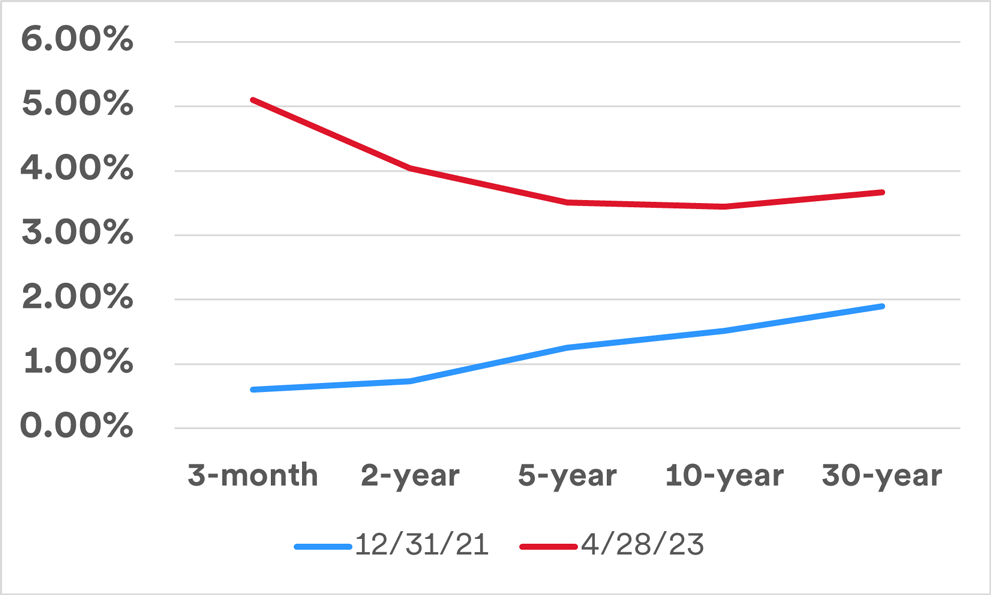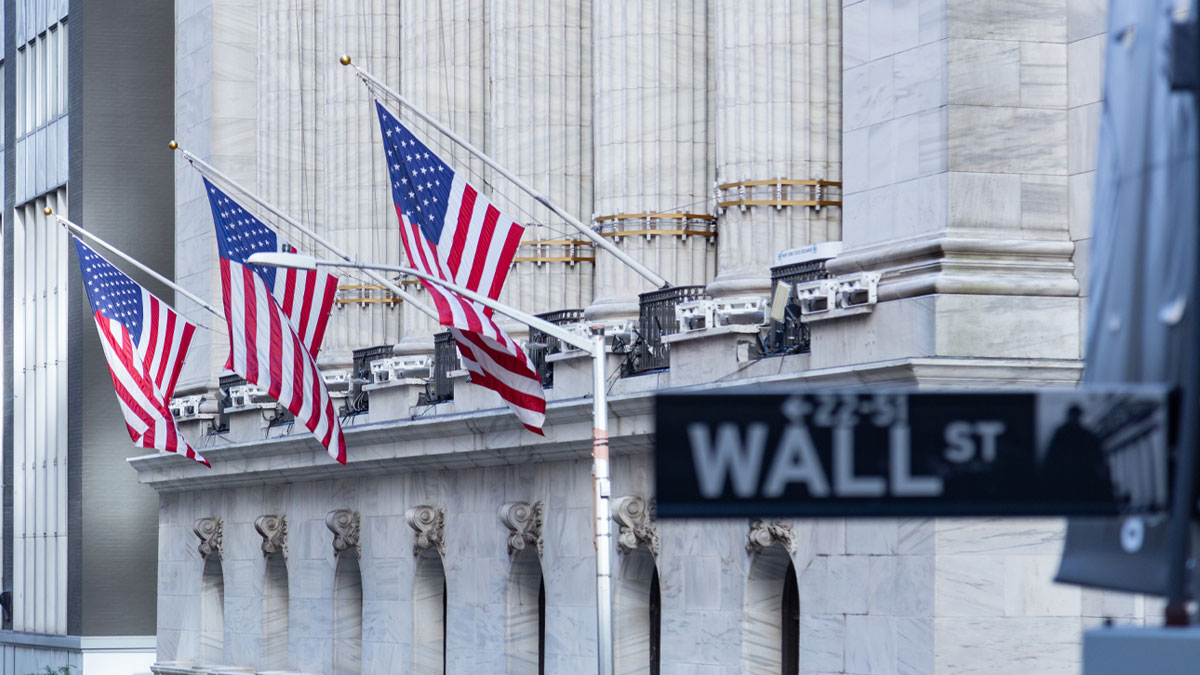Webinar replay: Spring investment outlook

Key takeaways
Bond yields remain elevated, offering opportunities for investors.
Interest rates have fluctuated across the board, with some shorter-term securities offering the most attractive yields.
This is the result of an unusual “yield inversion,” with 3-month Treasury bills paying a higher interest rate than 10-year Treasury notes.
The bond market looks significantly different today than it did little more than a year ago. Yields are up considerably, reflecting the realities of higher inflation and interest rate hikes by the Federal Reserve (Fed).
To illustrate the fluidity of the market, consider what’s happened with the benchmark 10-year U.S. Treasury note dating back to the end of 2021. At that time, it yielded just 1.5%, reflecting a longstanding trend of lower interest rates. The yield then rose dramatically in 2022, peaking at more than 4% in October, a level not reached since April 2010.1 Since then, the yield has fluctuated in a range between 3.30% and 4.10%.
Investors continue to assess how persistently high inflation may affect the interest rate environment going forward. Economic growth has slowed in recent months, in response to the Fed’s policy decisions aimed at reducing inflation. What could future monetary policy moves by the Fed mean for the bond market and what are key considerations for fixed-income investors?
The changing bond market
While short-term events can temporarily affect the bond market, interest rates tend to follow long-term growth and inflation trends. Higher inflation often results in higher interest rates. Persistent inflation altered the landscape for bond investors. The cost-of-living (as measured by the Consumer Price Index of CPI) rose steadily in late 2021 and through June of 2022. CPI for the previous 12-month period peaked at 9.1% in June 2022. Bond markets experienced a delayed reaction, as interest rates didn’t begin to rise in response to the inflation surge until the opening weeks of 2022. Inflation has since declined, with the CPI at 4.9% for the 12-month period ending in April 2023. Despite that trend, interest rates remain elevated.
“Bond yields rose primarily because the Fed pivoted to a much more hawkish position, as investors anticipated aggressive interest rate hikes to rein in inflation,” says Bill Merz, head of capital markets research at U.S. Bank Wealth Management.
Rising bond prices work against existing bondholders because of the inverse relationship between bond yields and bond prices. When yields rise, prices of current bond issues fall. This is a function of supply and demand. When demand for bonds declines, issuers of new bonds must offer higher yields to attract buyers, reducing the value of lower-yielding bonds already on the market. This environment hit bondholders hard in 2022 and again in early 2023.
Fed’s influence on interest rates
The Fed uses interest rate hikes on the short-term federal funds rate it controls as a tool to raise borrowing costs to slow economic activity and reduce inflation. Fed Chairman Jerome Powell and other members of the policy-making Federal Open Market Committee (FOMC) made clear that the Fed’s “easy money” policies from 2020-21, which included maintaining a near 0% federal funds target rate (a short-term interest rate the Fed controls), had to change in response to rising inflation.
“Our emphasis is on high-quality investment-grade taxable and municipal bonds to manage overall portfolio risk exposure should the economy continue to slow.”
Bill Merz, head of capital markets research at U.S. Bank Wealth Management
The Fed pursued an aggressive interest rate policy, and between March 2022 and May 2023 had raised the fed funds rate by 5.00%, a significant turn of events. However, after its latest action, the Fed signaled that it may pause rate hikes for the time being as it continues to “closely monitor incoming information and assess the implications for monetary policy."2
Inverted yield curve persists
A phenomenon that developed in 2022 and continues in 2023 is the unusual shape of the yield curve representing different bond maturities. Under normal circumstances, bonds with longer maturity dates yield more, represented by an upward sloping yield curve. It logically reflects the thinking that investors should earn a return premium for the greater uncertainty inherent in lending money over a longer time period. The current environment is unusual, as yields along the maturity spectrum now reflect an inverted curve.
U.S. Treasury Yield Curve Comparison
Dec. 31, 2021 and Apr. 28, 20231

The curve is generally downward sloping today, compared to the normal upward sloping curve. Most notable is the inversion between 3-month and 10-year Treasury yields, which became more pronounced in recent months. A common view of many analysts is that such a yield curve inversion signals increased odds of a recession in the future. “The deeper inversion lately may be a sign that the markets anticipate a more prolonged slowdown in the economy,” says Haworth. “For corporate borrowers, the cost of capital is going up, increasing the required rate of return for successful projects or investments.”
How far will the Fed raise interest rates?
After year-over-year inflation peaked in June 2022, inflation has trended lower, but even at the level of 5.0% for the 12-months ending in March 2023, remains well above the Fed’s target inflation rate of 2% annually.2 “Decelerating year-over-year inflation is constructive,” says Merz, “but we need to see much more before the Fed is likely to reverse course on interest rates.”
Merz also notes that there’s a lag time between when the Fed puts interest rate policy into place and its effects on the broader economy. “Many economists believe the impact is felt 12-18 months after a change in interest rate policy, though some believe that lag is shorter,” says Merz. He expects inflation to continue decelerating but remain sufficiently elevated that it results in pressure on the Fed to maintain higher interest rates, even if it stops raising rates further.
At the same time, developing issues such as troubles facing regional banks and the economy’s slower growth raise questions about whether higher rates have already taken a toll on the economy. “There’s an old saying that the Fed keeps hiking interest rates until something breaks,” says Haworth. But even if the Fed pauses rate hikes for now, it appears steadfast in its commitment to higher rates for now given that inflation remains well above its 2% annual target range
External events can also impact inflation trends. Fallout from Russia’s invasion of Ukraine is a prime example. Russia is a major energy producer, particularly for Europe, while both countries are significant agricultural exporters. The conflict affects the flow of oil, natural gas and food products. Lower supplies can result in higher prices for those products. “That’s outside the control of central banks,” says Merz. “Interest rate hikes by the Fed, the European Central Bank and others are meant to slow demand, but they don’t improve supply.”
An economic slowdown could also alter the general upward trend of interest rates. Despite recent events and the Fed's ongoing efforts to slow economic growth, Haworth says a recession in 2023 is not a certainty. “Much of the underlying economic data remains solid, but we’ll have to see if consumers begin to pull back on spending.” To this point, consumer spending has helped keep the economy moving in a positive direction.
Supply and demand issues can also affect yields on bonds in the broader market. With the Fed dropping out as a buyer of Treasury bonds and mortgage-backed securities, other buyers have to step up. “The private market and foreign buyers must absorb the supply of Treasury securities the Fed is no longer buying,” says Haworth. To this point, there are limited liquidity issues in the U.S. Treasury market, but if that becomes a problem, it could drive interest rates higher. Haworth is watching the direction of the federal government’s budget deficit. “If deficits move lower, the market likely has capacity to absorb new bond offerings,” says Haworth. “But if deficits move higher, it becomes more challenging.”
Finding opportunity in the bond market
What are the best options for bond investors in today’s market? Opportunities appear more attractive given today’s higher yields. “Investors who have money sitting in cash can earn much more competitive rates owning bonds with relatively short holding periods of three months to two years,” says Haworth. For an existing bond portfolio, Haworth says investors can reach out further on the maturity spectrum, where reasonable yields can be locked in for a longer term.
In addition, investors may want to focus on safety and quality. “We’re putting greater emphasis on core bond holdings,” says Merz. “We believe that bonds offer compelling defensive characteristics relative to stocks.” Specifically, he recommends both taxable bonds and, where appropriate, tax-exempt municipal bonds. “Our emphasis is on high-quality investment-grade taxable bonds as well as a dedicated exposure to short-term U.S. Treasury investments to manage overall risk exposure should interest rates continue to rise in the near term,” says Merz. For certain more tax-sensitive investors, a modest allocation to high-yield municipal bonds is also an option to consider.
There is an important potential benefit for bond investors who concentrate more of their bond positions in high-quality segments of the fixed income market. “This is a way to add diversification to help manage risks in a portfolio that includes equities,” says Merz. While a rarity occurred in 2022 as both stocks and bonds declined in value, Merz believes that over the long run, holding high-quality bonds will typically help smooth volatility in an investor’s diversified portfolio.
According to Merz, “This remains a time when investors are likely to benefit from holding more high-quality assets and fewer volatile assets than in a typical period.”
Talk to your wealth professional for more information about how to position fixed income investments as part of a diversified portfolio.
Tags:
Related articles

Capital markets gauge financial sector contagion risk
Our investment strategists assess capital market implications stemming from the recent failures of Silicon Valley Bank and Signature Bank.

How to put cash you’re keeping on the sidelines back to work in the market
Don’t let market volatility and an uncertain economic outlook derail your disciplined investing strategy.
